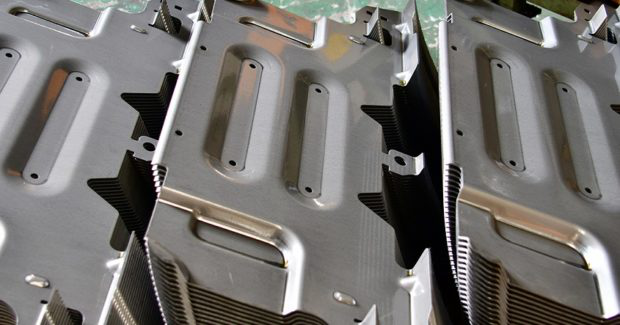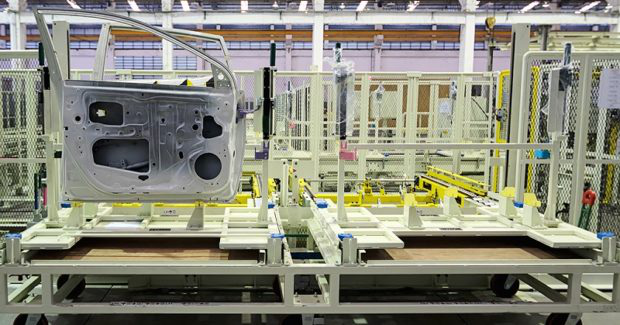2019/08/30 14:00 | Pageview:2067 | From: Fabricating and Metalworking
To reduce wear and tool breakage when forming or blanking AHSS material, here are some tips on revisiting the type of tool steel used, the design of the tool itself, and whether or not adding a coating or surface finish will improve performance and provide longer tool life.

Like most manufacturers, stampers are under continuous pressure to maximize green time and improve productivity. However, as the use of advanced high-strength steel (AHSS) expands to an ever-growing number of industries, many are finding themselves spending more time in the tool room with dies that are in need of repair and no longer producing. The automotive industry was among the first to use AHSS to lightweight certain components, a trend driven by the demand to boost fuel economy without sacrificing safety or performance. With these new materials boasting superior strength and the potential to reduce part weight by up to 25 percent or more, it's no surprise other industries are following suit and increasingly using AHSS materials in their manufacturing.

AHSS materials are stronger, thinner and more ductile, making them an excellent choice for lightweighting components in industries ranging from aerospace to appliances. At the same time, these qualities are extremely hard on stamping punches and dies, causing tools to wear or break prematurely in comparison to mild steels. This occurs when the higher yield strength and increased tensile strength of the AHSS material being formed or blanked exceeds that of the tool steel used to manufacture tooling. As a result of the increased stress, tools begin to shear and eventually break. To overcome this challenge and keep tools in production it is necessary to reconsider the tooling itself and make adjustments to reduce wear and tool breakage. While the solution for each application will be different, some things to consider include the type of tool steel used, the design of the tool itself, and whether or not adding a coating or surface finish will improve performance and provide longer tool life.
But first, you must evaluate the extent of the damage: Is it a simple matter of excessive wear and tear? Are there signs of micro-fracturing, potentially leading to breakage? Or is the punch head breaking with no obvious signs of wear? Understanding the deeper nature of the problem will help determine the most effective solution.
1. Change the Tool Steel
Much like the evolution of AHSS, tool steels continue to evolve in their own right to meet the needs of stampers facing increasingly challenging materials and applications. Whereas punches made with standard tool steels were once adequate for most applications, they could not withstand the rigors of forming or blanking the AHSS of today. High-speed or powdered metal tool steels are much more suited to stamping AHSS. M2 is a conventional high-speed steel with good toughness, wear resistance and high compression strength. However, if the punch is showing signs of wear, a particle metallurgy high-speed steel with higher carbon and vanadium content, such as PM-M4, provides better wear resistance. For even tougher applications where micro-fracturing is apparent or the punch head breaks altogether, PM-3V tool steel offers the greatest level of impact resistance.
2. Adjust the Tool Design
The plastic deformation caused by piercing and forming AHSS puts significant pressure on stamping tools. Adjusting the geometry of the tool can help minimize some of the pressure and maximize tool life. For instance, shorten the length of the punch body. Or increase the size of the tool body to spread the stress of impact over a larger surface area. Adding a shear angle to the punch head significantly reduces the tonnage and recoil within the punch, reducing wear and tear on the punch and minimizing punch head breakage. Additionally, back tapers reduce heat and friction on the punch head, minimizing stripping, reducing galling, and greatly improving wear resistance.
3. Switch the Surface Finish
Sometimes making small changes to your tooling is enough to produce big gains in tool life and performance. Something as simple as switching the surface finish from a circular to a straight-line grind, which changes the direction of the grain, can reduce stripping pressures and minimize galling. The addition of a surface finish change not only improves wear resistance, but can result in a cleaner, more accurate punch and a higher quality part.
4.Add a Coating
Specialty coatings are an excellent way to boost performance and extend tool life by as much as seven times that of untreated tooling. Determining the best coating for your application will depend on a variety of factors, including: the material being pierced or formed, the presence of material adhesion or galling, whether or not there is fracturing on the cutting edge, the type of lubrication, and more. Fortunately, there are an ever-growing number of coating options to choose from to solve a variety of challenges. Each offers a combination of benefits ranging from greater wear resistance, reduced galling, added lubricity, increased hardness and more.
Ultimately, the right mix of tool steel, design, coating and finish will depend on the specific needs of your application. Keep in mind that as our industry continues to adapt and evolve to the industries we serve, it's likely that the best solution available today may be surpassed by new technology down the road. Finally, consider consulting a variety of industry experts to gain a better understanding of the complexities of working with AHSS. Material suppliers can offer valuable insight on the strengths and weakness of the materials being used. Your tooling supplier can tell you what options are available for the variety of AHSS materials and what they recommend to help you get the longest possible tool life and highest level of performance out of your stamping tools.
